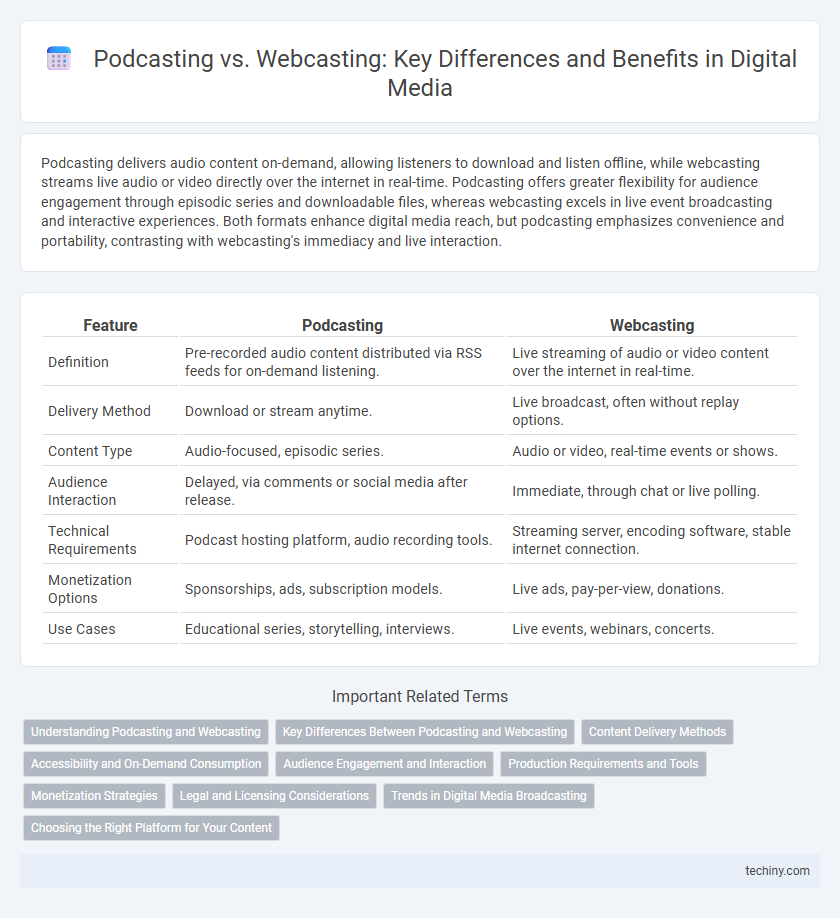Podcasting delivers audio content on-demand, allowing listeners to download and listen offline, while webcasting streams live audio or video directly over the internet in real-time. Podcasting offers greater flexibility for audience engagement through episodic series and downloadable files, whereas webcasting excels in live event broadcasting and interactive experiences. Both formats enhance digital media reach, but podcasting emphasizes convenience and portability, contrasting with webcasting's immediacy and live interaction.
Table of Comparison
| Feature | Podcasting | Webcasting |
|---|---|---|
| Definition | Pre-recorded audio content distributed via RSS feeds for on-demand listening. | Live streaming of audio or video content over the internet in real-time. |
| Delivery Method | Download or stream anytime. | Live broadcast, often without replay options. |
| Content Type | Audio-focused, episodic series. | Audio or video, real-time events or shows. |
| Audience Interaction | Delayed, via comments or social media after release. | Immediate, through chat or live polling. |
| Technical Requirements | Podcast hosting platform, audio recording tools. | Streaming server, encoding software, stable internet connection. |
| Monetization Options | Sponsorships, ads, subscription models. | Live ads, pay-per-view, donations. |
| Use Cases | Educational series, storytelling, interviews. | Live events, webinars, concerts. |
Understanding Podcasting and Webcasting
Podcasting offers on-demand audio content distribution, allowing users to subscribe and listen anytime through RSS feeds, making it ideal for personalized consumption. Webcasting streams live or scheduled audio or video content directly over the internet, enabling real-time interaction and event broadcasting to a wide audience. Understanding the fundamental difference lies in podcasting's download-and-play model versus webcasting's live streaming format, each serving distinct content delivery preferences in digital media.
Key Differences Between Podcasting and Webcasting
Podcasting involves the distribution of pre-recorded audio episodes that users can download or stream at their convenience, often via RSS feeds, whereas webcasting refers to live streaming of audio or video content in real-time over the internet. Podcasting enables on-demand consumption with episodic series, while webcasting is typically event-driven and synchronous, catering to live audiences. The technology behind podcasting supports offline access and subscription models, contrasting with webcasting's focus on live engagement and immediate interaction.
Content Delivery Methods
Podcasting delivers pre-recorded audio episodes downloadable for on-demand listening, enabling users to access content anytime without needing a live connection. Webcasting streams live audio or video content over the internet, requiring real-time participation and often featuring interactive elements like live chats or Q&A sessions. Both content delivery methods leverage internet distribution, but podcasting emphasizes flexible consumption while webcasting prioritizes real-time engagement.
Accessibility and On-Demand Consumption
Podcasting offers greater accessibility with downloadable episodes that users can listen to anytime, enabling flexible on-demand consumption. Webcasting typically involves live streaming, requiring real-time access, which can limit availability for users in different time zones or with inconsistent internet connections. The asynchronous nature of podcasting enhances user convenience by providing content without the constraints of scheduled broadcasts.
Audience Engagement and Interaction
Podcasting excels in audience engagement by offering on-demand, personalized content that listeners can consume anytime, enhancing retention and loyalty. Webcasting enables real-time interaction through live chats, polls, and Q&A sessions, fostering immediate audience participation and community building. Both platforms leverage unique engagement tools, with podcasting prioritizing convenience and depth, while webcasting emphasizes live interaction and dynamic feedback.
Production Requirements and Tools
Podcasting production requires audio recording and editing software such as Audacity or Adobe Audition, with a focus on high-quality sound capture using microphones and mixers. Webcasting involves live streaming tools like OBS Studio or Wirecast, demanding real-time encoding and internet bandwidth for seamless broadcast. Both formats rely on platforms like Spotify or YouTube for distribution, but webcasting necessitates more robust network infrastructure to support live audience interaction.
Monetization Strategies
Podcasting monetization strategies often rely on sponsorships, listener donations, and premium content subscriptions through platforms like Patreon and Apple Podcasts Subscriptions. Webcasting monetization typically includes live advertising, pay-per-view access, and integrating e-commerce through interactive features within real-time broadcasts on platforms such as Twitch and YouTube Live. Both formats increasingly leverage dynamic ad insertion and data analytics to maximize revenue by targeting specific audience demographics.
Legal and Licensing Considerations
Podcasting and webcasting differ significantly in legal and licensing considerations, with podcasting often requiring individual episode licenses due to on-demand distribution, while webcasting demands real-time streaming licenses under broadcasting laws. Compliance with copyright regulations, such as obtaining performance rights and mechanical licenses, is crucial for both but enforced differently based on delivery method. Understanding the distinctions in digital rights management and royalty payment structures helps content creators avoid infringement and ensures lawful monetization.
Trends in Digital Media Broadcasting
Podcasting continues to dominate digital media broadcasting with on-demand audio content tailored for niche audiences, leveraging personalized algorithms for enhanced user engagement. Webcasting trends emphasize live streaming innovations, integrating real-time interactivity and multi-platform distribution to capture broader audience participation. Emerging technologies like AI-driven content recommendations and 5G connectivity accelerate growth in both podcasting and webcasting, reshaping consumption patterns and expanding market reach.
Choosing the Right Platform for Your Content
Podcasting offers on-demand audio content accessible across major platforms like Apple Podcasts and Spotify, ideal for serialized storytelling and niche audiences. Webcasting delivers live streaming experiences suited for real-time events, webinars, and interactive sessions through platforms such as YouTube Live and Facebook Live. Selecting the right platform depends on content format, audience engagement goals, and desired interactivity, ensuring maximum reach and impact for your digital media strategy.
Podcasting vs Webcasting Infographic

 techiny.com
techiny.com